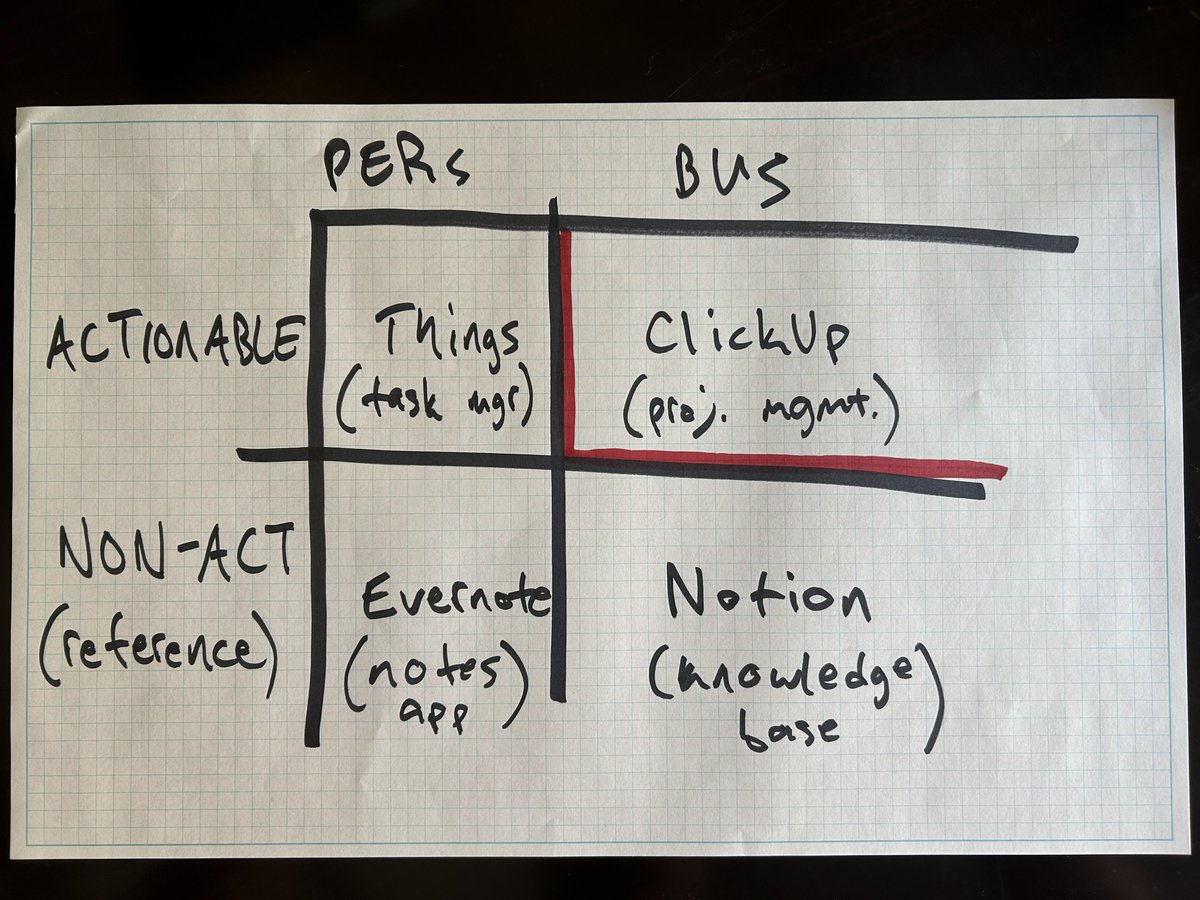# Tweets From Tiago Forte

## Metadata
- Author: [[@fortelabs on Twitter]]
- Full Title: Tweets From Tiago Forte
- Category: #tweets
- URL: https://twitter.com/fortelabs
## Highlights
- Can't believe my YouTube videos have received 1,500,000+ views already.
Here are my 5 most popular videos (and what you can learn from each one): ([View Tweet](https://twitter.com/fortelabs/status/1533955430392766465))
- Thanks, @Mappletons for this incredible illustration summarizing PARA: https://t.co/aHB4udm18B
 ([View Tweet](https://twitter.com/fortelabs/status/1520477369160679425))
- PARA stands for Projects — Areas — Resources — Archives
These 4 top-level categories encompass every type of information you might encounter in your work and life. https://t.co/zZC2SVsaiT
 ([View Tweet](https://twitter.com/fortelabs/status/1600494653593239552))
- My basic productivity setup:
I use different tools for personal vs. business and for actionable vs. non-actionable information
Here's what each tool is for... https://t.co/7wOKp4HyeF
 ([View Tweet](https://twitter.com/fortelabs/status/1675180284696731648))
- People often ask me how values and goals play a role in building a Second Brain
How does everything fit together?
To me, it's a pyramid with several layers!
Let me explain... https://t.co/WyuVwo4QMp
 ([View Tweet](https://twitter.com/fortelabs/status/1674095130301562887))
- Just realized there are really only 4 ways of changing the structure of your second brain:
1. Move a group of notes
2. Move one note
3. Tag a group of notes
4. Link one note with another
They fall neatly into this grid: https://t.co/8zdxQkHcmz
 ([View Tweet](https://twitter.com/fortelabs/status/1637861075214565376))
- Sometimes, when you’re trying to be nice, you’re not being kind
It’s kind to share how you truly feel
It’s kind to surface what doesn’t work for you
It’s kind to tell people the truth
But that means you probably won't come off as nice
You have to choose! ([View Tweet](https://twitter.com/fortelabs/status/1682065436773433344))
- My all-time top 5 reads:
• The Source by James Michener
• Hyperion by Dan Simmons
• The Untethered Soul by Michael Singer
• Rich Dad, Poor Dad by Robert Kiyosaki
• Getting Things Done by David Allen
What are yours? ([View Tweet](https://twitter.com/fortelabs/status/1698667835029913885))
- I'm proud to present the latest iteration of my Digital Productivity Pyramid!
This is my ongoing attempt to create a Grand Unified Theory of Productivity that ties together all the various productivity tools and concepts into one overarching model of how humans create value in the digital age
It's basically my conspiracy theory that I 100% stand behind ;)
Let me walk you through it step by step...
**Level 1 is Digital Literacy**, i.e. the basics of how to use computers effectively.
Before you can do anything else, you have to learn a whole series of skills:
How to browse the web, send and receive emails, use keyboard shortcuts, manage passwords, etc.
These make up one's basic literacy in the digital world, and learning them allows you to proceed to the higher levels
**Level 2 is Time Management**, i.e. how to deploy your most fundamental limited resource, time
The second half of the 20th century was dominated by this question, and saw the introduction of the first digital productivity tools for widespread use:
Email, calendars, and early versions of to-do apps, notetaking apps, and bookmarking apps
This was the first time that ordinary people saw their time as a valuable economic asset, and began to "invest" it as such
These early tools allowed people to manage the "fundamental particles" of their day, which are units of *time*: meetings, appointments, calls, and other events
**Level 3 is Task Management**, i.e. how to organize information to maximize the use of an even more limited resource, your attention
As the 21st century dawned, there was no time left to save, and we began to realize that value was created not by raw hours spent, but by the *quality* of attention applied
Getting Things Done (GTD), released in 2001, popularized personal productivity for the first time, giving people a way to organize information in such a way as to maximize the use of their attention
GTD added a *methodological layer* on top of an existing productivity tool from the previous era: the task manager. Concepts like the Capture Habit, Next Physical Action, Project Lists, the Weekly Review, and Contexts taught people how to use increasingly powerful software
This was the first time that innovation was driven not by new *tools*, but by new *concepts*. The frontier of innovation at Level 3 shifts to ways of organizing and conceptualizing units of work in abstract terms
Those units of work are units of *action*: tasks and to-dos, projects, areas of responsibility, and goals
**Level 4 is Knowledge Management**, i.e. using ideas and knowledge, both your own and others', to create reusable assets that deliver value even when you're not there
It's still important to spend your time wisely and focus your attention strategically, but neither of those are the decisive factors in your ability to create value anymore
Both of those are *inputs*, but what really matters now are the *outputs*: the quality and quantity of the knowledge artifacts that emerge from your labor
No one cares how hard you're trying at this level. If your outputs don't solve a problem for someone or otherwise create value, it doesn't matter how many hours you spent or effort you exerted
Using digital tools and online distribution platforms, one might very well create more value in a couple hours of creative work than a year of mindless grinding
What makes a difference at this level are frameworks for:
• Organizing knowledge (such as my PARA Method, to facilitate putting new ideas out into the world, which is the best way of improving them)
More on PARA: https://t.co/6dOPtFDjvR
• Distilling knowledge (such as my Progressive Summarization method, for visually structuring information for rapid retrieval)
More on Progressive Summarization: https://t.co/XVh1nra5aE
• Expressing knowledge (such as Intermediate Packets, small reusable chunks of content that can be reused and reassembled over time like LEGOs)
Examples of Intermediate Packets: https://t.co/AXb6SsHePS
Whatever the particular technique you use, the most important building blocks at this level are units of content: notes, knowledge, content, ideas
All the technology needed for effective knowledge management at the individual level was created long ago. Notetaking apps and bookmarking apps (now called read-later apps) have been around for decades, having been first introduced at Level 2. What's been missing is a *holistic framework* to link together all those pieces of tech into one system
I call that system a Second Brain, and in this video I explain which apps make it up and how it works:
https://t.co/aR8niRrgoM
So what's next? Level 5 is still developing, and we don't know for sure what it entails. But it's clear some elements will be pivotal:
• **Project management**: projects are increasingly becoming the most important unit of work, as teams go fully remote and organizations become porous and networked. The project represents a unit of progress that everyone can agree on
• **Working "just-in-time"**: we now have so many existing knowledge assets at our disposal, and such powerful tools for stitching them together or synthesizing new ones, the ability to rapidly move an idea from conception to execution is becoming paramount
• **Creative endeavors**: creativity is of course the final frontier of value, and increasingly the only moments that matter are our singular creative leaps and breakthroughs. All the tools and techniques of productivity only exist to manifest our creative visions into the world, and we can finally focus most of our attention on doing exactly that
• **Artificial intelligence**: underlying and driving the 3 points above, obviously AI is fundamentally reshaping what work should be done by humans at all. Increasingly, if you can imagine it (and describe it, provide feedback on it, fine tune it, and package it) then you can create it. But that all depends on having a refined sense of taste about what's good, a strong point of view about what matters to you, and the self-understanding and understanding of others to know what is truly needed in the world
For a big picture view of this history of productivity, watch this video:
https://t.co/ZlP2svS9ao<img src='https://pbs.twimg.com/media/GAh9H9zbEAAWogz.jpg'/> ([View Tweet](https://twitter.com/fortelabs/status/1731780317105750049))
- If I’ve managed to complete a project during the week, I follow my Project Completion Checklist
Reaching the end of a project isn’t just about crossing the finish line, it’s about integrating it into the bigger picture of your knowledge management system
Here’s my checklist: ([View Tweet](https://twitter.com/fortelabs/status/1734649713431884204))